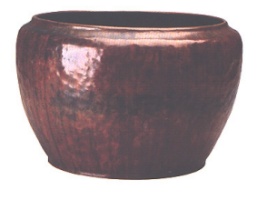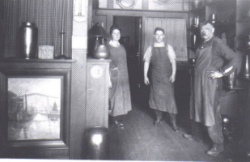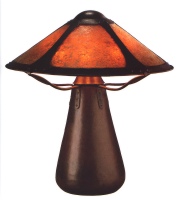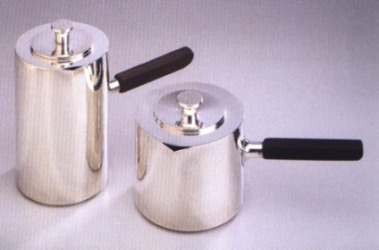(click on images to enlarge)
Forging Modernities: California Metals in Context
A Conference in Oakland and the Bay Area
-part 1-
This conference took place in Oakland and the Bay area from November
12 - 14, 2004 and was wonderfully organized by Lisa Koenigsberg and her
able assistant, Patrick Vega., both New York University, School of
Continuing and Professional Studies. The aim of the conference was to
examine the development of modernity in California and to give an up to
date description of the modern scene in metalsmithing.
November 12
W.Scott Braznell, an independent scholar and specialist in modern
American design, gave an outline of the beginnings of metalsmithing in
California. With its promise of a better life and gold as a catalyst,
California was able to attract people from all over the world and all
walks of life.
The gold rush of 1848 and the discovery of silver in the Comstock Lode
in western Nevada in 1859 provided the ready cash to develop San
Francisco from a meager outpost to a civilized city. History and
folklore are embedded in Californian silver - Indian motifs and
Californian flora and fauna are used in early silverworks.
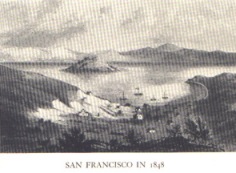 |
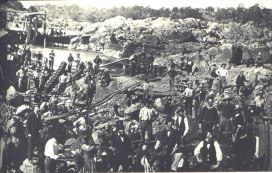 |
San Francisco 1848 in E. Hungerford:
Wells Fargo, NY 1949, page 53
|
Miners in the West 1851, in: T.H.Watkins:
Gold and Silver in the West, 1971, page 37
|
The Californian natural environment was also the main inspiration for
early studio artists, later on European modernism was enthusiastically
embraced, European immigrant designers like Dirk van Erp played a major
role in developing the specific Californian Arts and Craft Style.
Suzanne Baizerman, a curator of Crafts and Decorative Arts,
Oakland Museum of California, held a very interesting lecture about
Californian exhibitions and expositions. The Mechanics Fair of 1878 was
an important showcase for the early silversmiths such as Frederick
Reichel, William Vanderslice and George C. and Samuel Shreve.
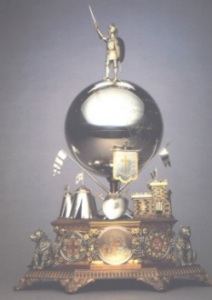 |
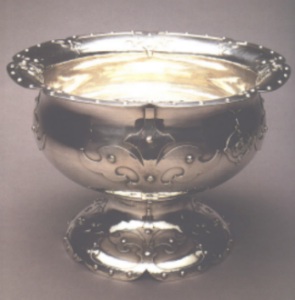 |
George C. Shreve & C. – Trophy, silver,
gold, gold quartz, San Francisco 1883,
in Silver in the Golden State,
Oakland Museum 1986, Back cover
|
Shreve & C. Punchbowl
in XIV century pattern,
in Silver in the Golden State,
Oakland Museum 1986 plate 12
|
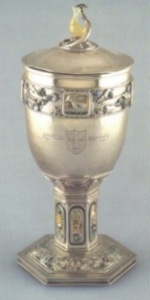 The Panama Pacific Exhibition of 1911 was a symbol of rebirth after
the horrible fire, which devastated San Francisco. Many metalsmiths
exhibited their wares: Shreve and Co. introduced their attractive
14th century flatware line, which is stamped out with dies but
suggests handwork.
The Panama Pacific Exhibition of 1911 was a symbol of rebirth after
the horrible fire, which devastated San Francisco. Many metalsmiths
exhibited their wares: Shreve and Co. introduced their attractive
14th century flatware line, which is stamped out with dies but
suggests handwork.
Copper works such as lamps and smoking sets were the speciality of
Dirk van Erp and Harry Dixon. Ernest Batchelder and Donald Donaldson
were two more influential proponents of the Arts and Craft Movement.
Donaldson, an inventive and technically very accomplished jeweler,
enameler and silversmith, made a covered chalice, for which he won
the gold medal at the Panama-Californian Exposition in San Diego.
|
Covered chalice by Douglas Donaldson, 1914,
The Arts and Craft Movement in California, Oakland Museum, p.178
|
Modern exhibitions like “California Design 1910”, in 1974 by the
Pasadena Museum of Art and above all “The Arts and Craft Movement in
California, Living the Good Life”, in 1993 at the Oakland Museum
inspired renewed interest in the Arts and Craft Movement of California.
A guest curator at “California Design 1910” Bonnie Mattison and
Robert Judson Clark, professor emeritus of art and archeology,
Princeton University, lectured on the work of The Van Erp Family. During
the 1970s, many of the children of the original Arts and Craft designers
were still alive and Mattison met them and conducted many interesting
interviews.
The Van Erp Shop was a breeding ground for artisans of the Arts and
Craft Movement such as Alexander J. Robertson, Harry Dixon, Agatha van
Erp, to name a few. Dirk van Erp is best known for his elegant lamps
with mica shades, but his shop produced many other interesting objects
such as vases, jardinières, bowls, boxes, desk sets, book ends, waste
baskets, fireplace screens, etc. etc. After Dirk van Erp's death in
1933, his son William van Erp carried on the business. He worked as a
silversmith in the Bay Area into the mid 1970s.
Van Erp & D'Arcy Gaw, monumental copper
jardinière, 1910,
in The Arts and Craft Movement in California, Oakland Museum, p.27
|
Van Erp studio photo with daughter Agatha
and August Tiesselink, 1917,
in The Arts and Craft Movement in California, Oakland Museum, p. 148
|
Van Erp lamp with mica shade 1910,
in The Arts and Craft Movement in California, Oakland Museum, p.147
|
Todd Wells, collector, silver researcher and part-time dealer
and auctioneer, spoke about his favorite silversmith, Clemens Friedell.
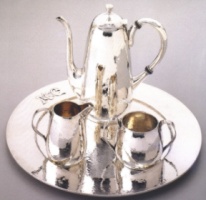 Friedell was not a card-carrying member of any Arts and Craft
organisations. Conventionally trained in Vienna, Austria and having
worked for Gorham on their prestigious Martele line, he came to
California in 1910, settled in Pasadena and established a successful
business. He was popular with the horsy set and specialized in
trophies and custom commissions for wealthy patrons.
Friedell was not a card-carrying member of any Arts and Craft
organisations. Conventionally trained in Vienna, Austria and having
worked for Gorham on their prestigious Martele line, he came to
California in 1910, settled in Pasadena and established a successful
business. He was popular with the horsy set and specialized in
trophies and custom commissions for wealthy patrons.
|
Teaservice by Clemens Friedell, hammered surface with chased
monogramm, 1910,
in The Arts and Craft Movement in California, Oakland Museum, p. 177
|
His masterpiece is the 107- piece dinner service, made for
millionaire brewer, Eddie R. Maier and featuring orange blossoms, 10000
to be exact – surely counted by Mr. Friedell himself. Since chasing is a
very costly technique, Clemens Friedell also made a more affordable line
in Arts and Craft style, featuring exquisite proportions, ornamented
only by hammer marks and wonderfully chased initials.
Cynthia Adler, an accomplished silversmith in her own right, was
supposed to speak about the work of her grandfather, Porter Blanchard,
her father Allan Adler, and her uncles Lewis Wise and Kenneth Adler.
Porter Blanchard, matching coffee and teaservers, 1930,
in The Arts and Craft Movement in California, Oakland Museum, p.181
Unfortunately she was not well enough to hold the lecture and we saw
slides showing the work of these important silversmiths.
Michael Weller, antique silver dealer par excellence, spoke about
Shreve &Co in the 1920's. He reminded us that even though decorative
arts lectures concentrate mostly on studio artists and their work, the
yearly output of silver items by a commercial firm like Shreve & Co.,
probably surpassed the number of items all the studio artists made
during their lifetime.
The Shreve Company in 1920 employed over 600 people and produced a very
wide range of silverware. The factory produced silver to a “price
point”, but also made fine custom orders.
Some years ago 1600 design drawings and two photo albums were found at
Shreve's San Francisco showroom, they were subsequently given to the
Fine Arts Museum of San Francisco and are awaiting thesis candidates for
further study and research. The photo albums show every piece of
equipment and every workroom in the factory. The factory employed
untrained workers and high-class silversmiths, the firm trained and
employed designers, often sending them abroad for schooling. Shreve's
created many elegant designs, which bowed to the Arts and Craft movement
and Michael Weller posed the question, if these products can be
considered master pieces of the Art and Craft Movement or must fall
wayside as industrial standardized production?
The day ended with a very entertaining lecture by Alice Kaufmann,
an independent writer for many publications on antiques. She talked
about Philip Paval, a Danish gold- and silversmith, whose successful
career seemed to have been more promoted by his social life as notorious
party animal and his drinking with the well-to-do than maybe his
creative talents.
If one wants to know more about P. Paval, read his autobiography,
'Autobiography of a Hollywood Artist', where his adventures and
achievements are described in more detail.
Further bibliography upon request
Dorothea Burstyn - 2004 -
member of ASCAS and President of Silver Society of Canada - email:
dburstyn@rogers.com
follows on
part 2 (click here)
|






